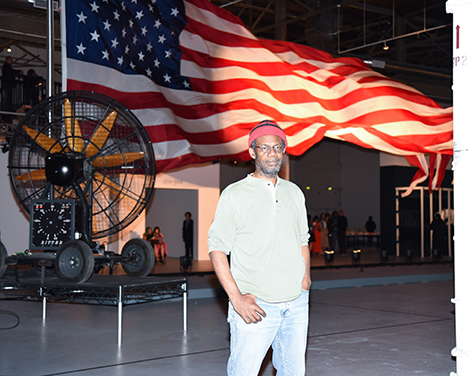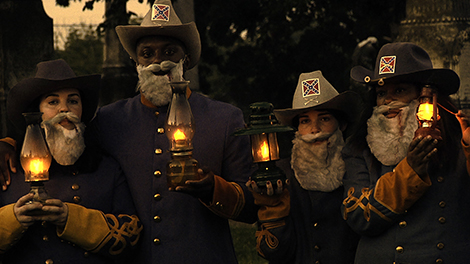It’s a long way, spatially, temporally and culturally from the cavernous interior of The Geffen Contemporary at MOCA to the idyllic rolling landscape of the Civil War battle field near Bull Run Creek in northern Virginia. But it is precisely that distance (among others) that William Pope.L bridges in his sweepingly ambitious installation and performance, “Trinket.”
Although the installation subsumes performance, construction, inscription, video—even a kind of inspired and slightly off-kilter agri-culture—the show’s centerpiece is undoubtedly the majestic Trinket (2008/2015), a gigantic American flag (16 x 45 feet) whipped during the museum’s opening hours by four huge industrial fans and giving every appearance of being a mammoth prop installed on a movie studio sound stage, an effect intensified by the dark, industrial vastness of the space itself. Slowly, but surely, this brutal treatment has the effect of fraying the flag from the end, the “natural” force of the wind harnessed to its systematic destruction. (It is, however, respectfully lowered and folded away during hours when the museum is dark.)
The presence of this immense Trinket easily dominates the entire interior space. Even when unseen, the whirring of the gigantic fans produces an overwhelming sound. The flag itself, with its incongruous extra star shines “transplendently” when fully lit. (And that extra star with its “queering of [mythological] identity,” is it “Puerto Rico or Canada or Cuba or Europe or a simulacrum for New Jersey?”) In any case, there is no denying the power of the flag’s presence, the facticity of its “being-there.” Yet it is not a static icon, like the “real” Star Spangled Banner displayed in the rotunda of the Smithsonian Museum of American History. Rather, it is a symbolic object whose meaning must be adjudicated through political and cultural contest. As Pope.L himself tells us in his text “Explanation #152,” “THE xxxx is not the territory.” Anyone can own a flag; but nobody can own the flag.

Portrait of William Pope.L at The Geffen Contemporary at MOCA, image courtesy of The Museum of Contemporary Art, Los Angeles, photo by Owen Kolasinski/BFAnyc.com
Around this rather equivocal icon, then, the rest of the show is spread. In an adjoining room, Polis or the Garden of Human Nature in Action (1998/2015) lays out what might easily be seen as an agricultural metaphor for the contest alluded to above, in the form of 15 large wooden tables (each 30 x 48 x 96 inches) on which have been arranged a virtual harvest of brightly painted onions (red, white and blue, and black and white) each sprouting or molding at its own pace. It may well be, as Pope.L seems to suggest, that all onions are somehow the same under their [painted] skins; but, in the face of the rest of the work, that, or any, conclusion is not really compelling.
Certainly, in Pope.L’s world, everyone seems an actor, whether performing in the actual flesh in the 2015 Migrant, which unfolds in a stark wooden-framed space confronting the flag like a static claustrophobic Other, or in one of the three videos screened on monitors scattered throughout the exhibition space. Of these, the most ambitious is surely Reenactor (2012/2015; a continuous 185-minute loop): an inspired cross between elegy and minstrelsy that moves an obviously reenacted General Robert E. Lee (a transparently disguised figure whose race and gender are both surprisingly labile) through an extraordinary cultural dreamscape of antebellum postmodernity. Often excruciating in its parody of the Lost Cause, it also provides moments of poignant self-reflection on deep and as yet unhealed cultural fissures that can be difficult to see from a vantage here in southern California.

William Pope.L, Polis or The Garden or Human Nature in Action (London version), 2006, Thomas Dane Gallery, London, England, photo by Thierry Bal, image courtesy of the artist.

Finally, a climb up to the second floor gallery yields a last, exquisite juxtaposition. Turning away from the view out across the open space below, where Trinket continues to billow and roar, it is possible to see, as if off in a forgotten corner, a fragmented shadow of the ever-billowing flag, like an undulating puff of smoke whipped by the wind. Against this ghostly, evanescent image is ranged a text: the 24 27 x 18-inch linen panels of Circa (2015). On each of these panels, in a dense impasto, we see the most minimal possible couplet: a pair of words, one always “fuschia,” the other always a rhyme ending in “a.” Only with considerable effort can we excavate the poetic text. “Fuschia ebola.” “Fuschia larva.” “Fuschia zebra.” “Fuschia bwana.” Et cetera. And only with considerably more can we, perhaps, excavate a sense. As in all the works on show here, that sense reveals itself only obliquely. It is both partly hidden, like the flag’s shadow, and in plain sight, like the flag itself. It is both available through our own effort and codified in a mysterious and holy book, our “Fuschia Torah.”



















0 Comments